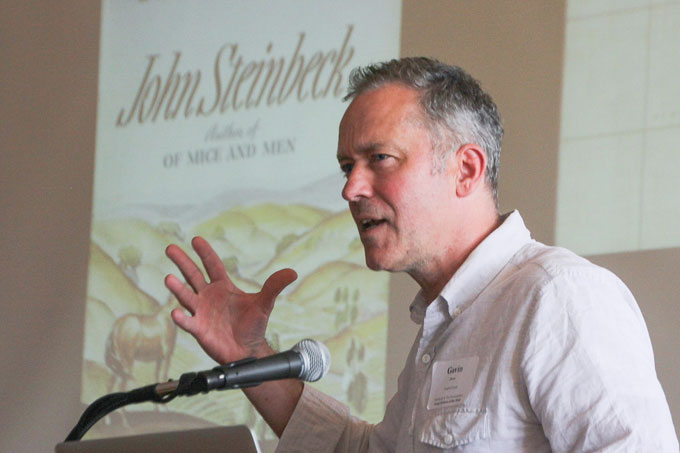If Gavin Jones had been a professor there 100 years ago, would John Steinbeck have stayed at Stanford University long enough to finish? Probably not, according to Jones, who addressed the fraught subject of Steinbeck@Stanford at the Stanford University Library on January 30. Jones—who holds the Frederick P. Rehmus Family Chair in Humanities in the Department of English—spoke to a capacity crowd of 200 at the evening event, which was sponsored by the Stanford Historical Society and included a pop-up exhibit from the library’s collection of Steinbeck manuscripts and memorabilia. Credited with contributing to the revival of campus interest in Steinbeck, who enrolled intermittently between 1919 and 1925, Jones used examples of Steinbeck’s early writing to show how Stanford’s emphasis on creativity, collaboration, and interdisciplinary learning shaped the character, context, and content of works like To a God Unknown and Cannery Row—manuscripts of which, in Steinbeck’s hard-to-read hand, were on display at the event. Although he left without earning a diploma and refused to accept an honorary degree, “Stanford was always on his mind,” said Jones. Assuming “the mythology of a misfit” early in his career, Steinbeck was a life-long experimenter whose insights into ecology, empathy, and eugenics—all shaped by Stanford—were, Jones added, ahead of their time and set him apart from literary figures like William Faulkner, who dropped out of Old Miss, and Ernest Hemingway, who skipped college to work as a reporter.
- Home
- Books
- Life
- Music & Media
- Places & Events
- Politics & Religion
- May 4, 2024
About John Steinbeck

Most read American writer of the 20th century. Born in California. Died in New York. Romantic. Realist. Rebel. More about John Steinbeck
FacebookTwitterLinkedInGoogle+ PinterestMySpaceStumbleUponYouTubeStay In Touch
Receive email updates and stay in touch with SteinbeckNow.com
Recent Posts
- New Video from San Jose State University on John Steinbeck: A Writer’s Vision
- Celebrate! Western Flyer Returns to Monterey Bay
- Henry Fonda’s Daughter, Jane Fonda, to Receive 2023 John Steinbeck Award
- A Chance Christmas Dinner with John Steinbeck in 1947
- Saved! John Steinbeck’s Retreat in Sag Harbor
- Celebrating Woody Guthrie’s Grapes of Wrath Connection
- John Steinbeck Haunts Malcolm Harris’s Palo Alto
- San Jose State Hosts Steinbeck Conference
- For John Steinbeck, the Rains in Pajaro Hit Home
- Photo Inspires Sumi Ink Portrait by Eugene Gregan


Very interesting.
Beside being a fly on the wall during meetings in Doc’s Lab, The Bear Flag, or the Palace Flop house during intellectual gatherings, I would love to know more about the discussions between Steinbeck and and Harold Chapman Brown, PhD who is mentioned in the Benson biography. I’d also like to read the Brown papers at Stanford.
You will be pleased to learn that Gavin Jones discussed this relationship in his remarks about faculty members who most influenced Steinbeck’s thinking at and after Stanford.
It is fascinating to hear more about how Stanford influenced JS’s writing, and to fill out a better picture of his love-hate relationship with educational institutions.
How wonderful that Professor Jones is there at Stanford. I hope there will be many more events and collaborations between the various Steinbeck constituencies and centers in the SF Bay area.
I consider myself a John Steinbeck diaspora having first encountered the writer through the award winning The Grapes of Wrath as a high school text book in 1983. A generation later, I am back full cycle helping my nephew with his school work on John Steinbeck’s other book, The Pearl. So here in Kenya, at some distant, Eastern corner of Africa we are a Steinbeck family and through his prisms we can see the economic ravages of the coronavirus pandemic just as JS saw the poverty and distress in the wake of the Great Depression.
Andrew,
I totally agree with you. People were also dying needlessly, though not as noticably from the coronavirus, when Steinbeck wrote Grapes of Wrath. I am glad kids in Kenya are reading him. Stay safe.
Indeed, Stanford was always on his mind. Despite his negative comments about life at Stanford, his letters to family and Stanford friends demonstrate his secret love for Stanford above all schools. He followed the football team religiously and showed off with pride whenever he learned a Stanford professor received honors nationally.